
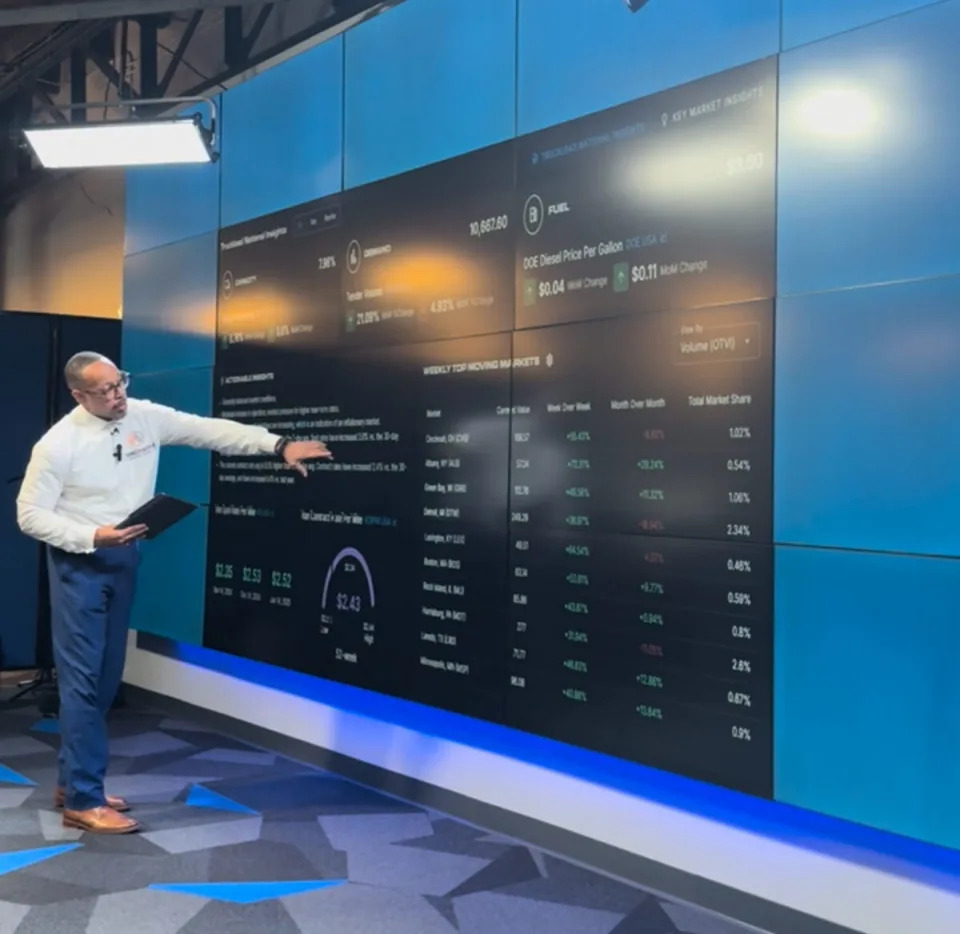
Welcome to the first edition of The Playbook.
Welcome to the very first edition of The Playbook, a weekly newsletter dedicated to small carriers and fleets. My name is Adam Wingfield, founder of Innovative Logistics Group – consider me your new mentor.
If there’s one thing I’ve learned in my 24-plus years in the trucking industry, it’s this: while the road ahead can be full of opportunity, too many small carriers find themselves stuck on the shoulder, unable to move forward. Many carriers start with the dream of independence and financial freedom, only to face challenges that force them out of business within their first year. I don’t believe anyone gets into business to fail, but life happens and sometimes you aren’t set up for success for a variety of reasons.
Why does this happen? It’s not a lack of drive or determination. It’s because the trucking community has long been underserved when it comes to business development and acumen. There is a vast amount of knowledge on the internet, but it is so diluted, widespread, and sometimes flat-out inaccurate. We know how to drive trucks and get freight delivered, but no one ever handed us a road map for running a sustainable and profitable trucking operation.
This gap in knowledge and resources is exactly why The Playbook was created. Through a powerful partnership between Innovative Logistics Group and FreightWaves, The Playbook is more than just another industry resource — it’s a game-changing hub designed to empower small carriers and owner-operators with the tools, insights, and strategies they need to thrive.
Let’s dive into this week’s edition of The Playbook.
What to Expect This Week
As part of our updated training format, you have two new sessions this week:

Wednesday:
New Masterclass as scheduled will drop in your Masterclass Portal.

Thursday at 7 p.m. EST: Small Carrier Market Update will also drop.
The Small Carrier Market Update is designed to give you real-time freight insights, fuel trends and market shifts , helping you make stronger, data-driven business decisions.
Be sure to attend both sessions and take advantage of the insights that will keep you ahead in today’s small carrier market.
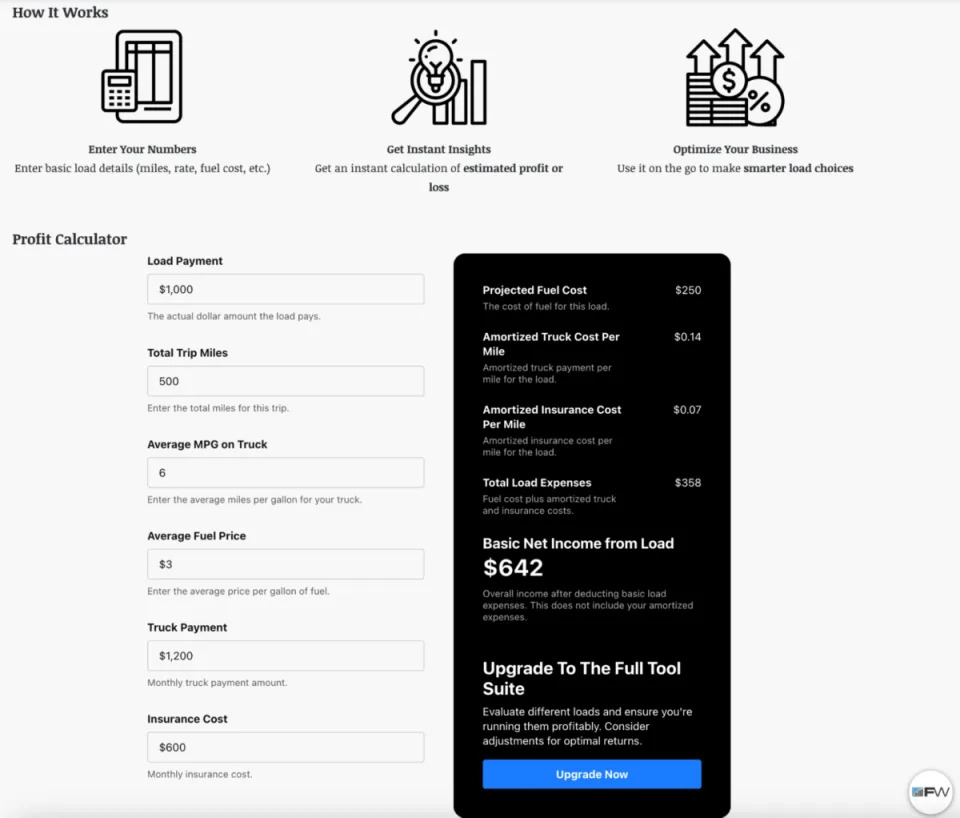
NEW: Quick Load Profitability Calculator
Making a bad load decision can cost you hundreds — if not thousands — of dollars over time. That’s why we’ve built the Quick Load Profitability Calculator , a fast and easy way to determine if a load is worth taking before you commit.
What it does:

Gives you an instant snapshot of whether a load is profitable.

Helps small fleet owners and owner-operators make fast, informed decisions.

Is designed for quick calculations — no deep data entry required.
This is a helpful tool if you’re looking to make smarter, faster decisions on the road. Try it out today.
If you need a more detailed breakdown of your cost structure — including variable expenses, breakeven analysis and true operating costs — you can upgrade to the Full Load Profitability Calculator for deeper insights. Access the Quick Load Profitability Calculator here: → https://www.freightwaves.com/playbook/profit-calculator
Trucking Market Update for the Small Carrier
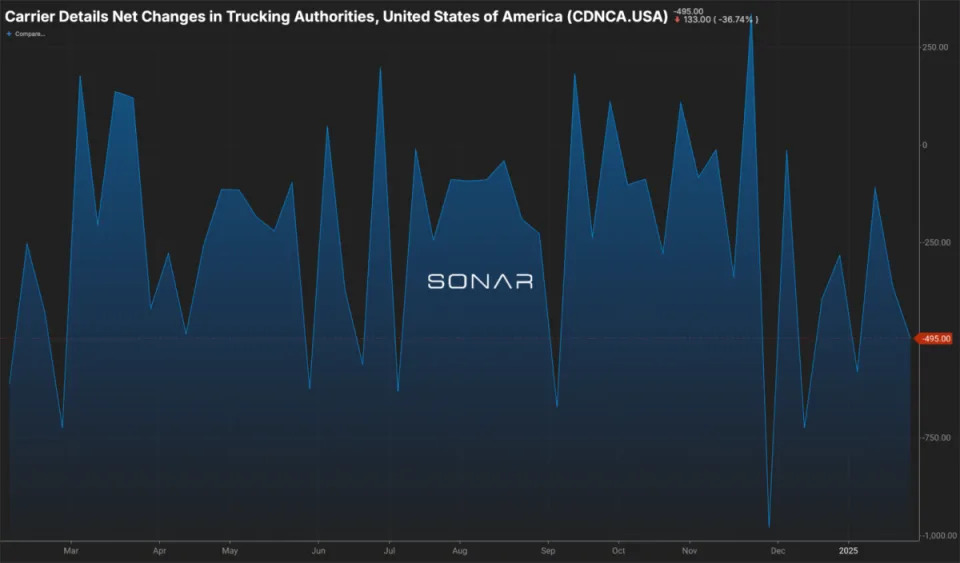
Market Update: Trucking Authority Net Changes Show a Continuing Exit Trend
If you’ve been paying attention to the market, this chart confirms what many small carriers have already been feeling — we’re still in a period of contraction. The net change in trucking authorities across the U.S. took another deep dive last week, with a net loss of 495 active carriers. That’s not just a number; that’s hundreds of small fleets shutting down or exiting the market entirely.
What’s Driving the Decline?
The trucking industry has been oversaturated for the past two years, with an explosion of new entrants flooding the market in 2021 and early 2022. Many of those carriers jumped in when rates were high, without a long-term financial strategy or an understanding of market cycles. Now, with rates normalizing and operating costs still high, we’re seeing a steady bleed-out of small fleets that simply can’t sustain profitability.
Another factor? Insurance renewals and rising compliance pressures. Many of the carriers exiting the market are facing higher renewal rates, increased scrutiny from brokers and an overall tougher environment to operate profitably without strong shipper relationships or cost control.
Why This Matters for Small Carriers Still in the Game
On the surface, fewer authorities could mean less competition — which is a good thing for those who know how to stay profitable. But the challenge is that many of the carriers exiting the market were operating at the lowest cost possible, underbidding lanes just to keep moving. As they exit, it will take some time for pricing to rebalance and reflect a more sustainable market.
The key right now is operating with discipline. If you’re still in the game, this isn’t the time to take every load that comes your way just to keep wheels turning. It’s time to run smarter, not harder. Look at cost per mile, focus on high-value lanes, and build direct relationships to avoid excessive broker cuts.
What’s Next?
Expect more carriers to exit the market over the next few months, especially as Q1 historically brings slower freight volumes. The carriers that make it through this phase will be in a stronger position when demand picks up.
The takeaway? Survival is about strategy. The data is showing us that the industry is thinning out, but that also means opportunities are opening up for those who understand the cycles and are ready to capitalize when the market turns.
This is why staying plugged in to real-time market data and adjusting your strategy accordingly is more critical than ever.
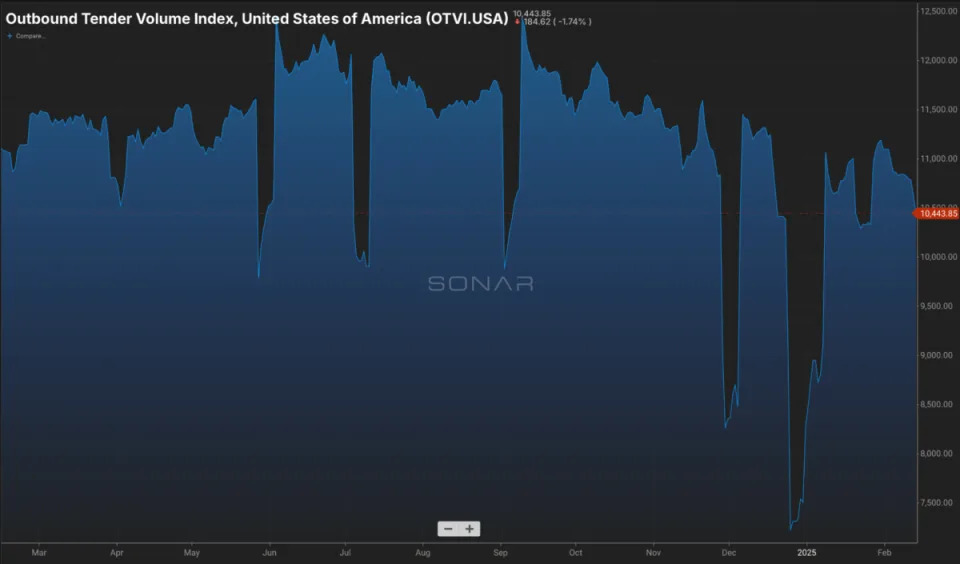
Market Update: Freight Volume Is Slipping – What That Means for Small Carriers
This chart is showing us outbound tender volume , which is basically how many loads are being offered up by shippers across the country. Right now, it’s sitting at 10,443.85 , down 1.74% from the previous period. That might not seem like a big drop, but the trend is what matters — and what we’re seeing is freight volumes slowly cooling off.
What’s Happening and Why It Matters
Think of outbound tenders like shippers throwing loads into a pool for carriers to grab. When tender volumes are high, more freight is available, meaning more opportunities for carriers to find loads at good rates. When volumes dip, there are fewer loads to go around, and competition gets tighter.
You can see on the chart that volumes were strong through most of last year , but there have been big dips around the holiday season — which is normal. The issue now is that instead of bouncing back quickly, freight volumes are struggling to gain momentum.
For the small carrier , that means:
Real-World Example: The Load Board Squeeze
Let’s say you’re running a dry van out of Atlanta. Last month, you could easily find a good-paying load heading to Dallas without much hassle. But now, you check the boards, and the rates are $200 lower than normal , with more trucks fighting over the same freight. That’s a direct result of this tender volume dip — less freight in the system means rates start getting squeezed.
How to Stay Profitable in This Market
The name of the game right now is lane selection and cost control. Here’s how to keep your business running strong while volume dips:
-
Focus on strong freight lanes – Stick to high-volume markets where outbound freight is still moving. Regions like Dallas, Atlanta and Chicago usually have steadier freight demand.
-
Cut down on deadhead miles – With fewer loads moving, every mile needs to count. Minimize empty running and get paid for every turn of your wheels.
-
Negotiate harder – If brokers try to lowball you, push back. Know your cost per mile and don’t run cheap just to keep moving.
-
Keep an eye on fuel prices – Diesel is trending lower , which helps cut costs, but that only matters if you’re booking profitable freight to begin with.
Bottom Line: Don’t Chase Freight — Plan Smarter
We’re in a transition period , where freight is available but not as strong as it was in peak seasons. Carriers that run smarter lanes, manage expenses and avoid cheap freight will ride through this dip without a problem.
This is why staying plugged in to the data matters. If you see tender volumes slipping, you adjust early — before you’re sitting at a truck stop for hours waiting on a decent load.We’ll keep tracking the market and bring you the next moves before they happen. Stay sharp, plan ahead, and keep your business moving in the right direction.
Connecting the Dots: Why Freight Rates Are Stuck in Neutral
We just looked at two important charts — one showing net revocations of trucking authorities (a lot of small carriers shutting down), and the other showing outbound tender volumes (how many loads shippers are offering). Put these together, and you can start to see why rates aren’t bouncing back like a lot of folks hoped they would.
Let’s break it down in plain terms.
Less Competition, but not Enough Freight to Matter (Yet)
The first chart told us that trucking authorities are still disappearing — 495 carriers just left the game. That means fewer trucks on the road, right? And if fewer trucks are available, shouldn’t rates go up?
Not so fast.
The second chart tells us the real story. Freight demand (the number of loads available) is also slipping. In a perfect world, when a lot of trucks leave the market but freight demand stays high, rates go up because shippers start competing for trucks. That’s not what’s happening right now. Instead, we have trucks leaving AND freight demand dropping at the same time. That keeps things stagnant — there’s still too much truck capacity chasing too little freight.
Supply and Demand: Why Rates Are Stuck
Think about it like this: Imagine a restaurant with 50 tables but only 20 customers coming in to eat . If five waiters quit, it doesn’t suddenly mean the restaurant is busier — the problem is, there still aren’t enough customers filling the seats.
That’s exactly what’s happening in trucking.
-
Fewer carriers on the road (supply dropping

).
-
But also fewer loads being shipped (demand dropping

).
With demand still weak, brokers don’t have to bid up rates because they know there are still plenty of trucks available for the loads they do have.
Why This Feels Different From 2021-2022
A lot of folks remember the freight boom of 2021-2022, when rates were hitting $3-plus per mile on the spot market and freight was everywhere. The difference back then?

More freight than trucks
→ Shippers had to fight for capacity.

Carriers could name their price → Brokers had no choice but to pay up.Right now, the balance isn’t there yet. The market is correcting (small carriers are still leaving), but until we see demand pick up and more loads hitting the system , rates will stay sluggish.
What Needs to Happen for Rates to Improve?
If you want to see better rates, you need one of two things to happen:
-
Freight demand needs to increase – More shippers pushing out more freight forces brokers to pay better rates.
-
More carriers need to exit the market – If enough trucks disappear, the ones left will finally get leverage.
Both of these are gradually happening , but it’s a slow burn.
How to Stay Ahead While the Market Adjusts
Until this market finds better balance,
small carriers need to be strategic.

Run efficient lanes
– Stick to markets that still have steady freight. It may mean running in a market you may not like.

Minimize empty miles
– Every dollar saved is a dollar earned.

Push back on brokers
– They’ll always try to squeeze you first — know your numbers and stand firm. This is where negotiation is key.

Watch for regional demand – Some areas will recover faster than others. Stay flexible.
The Bottom Line: A Market in Transition
We’re in a correction phase , plain and simple. Trucks are leaving but not fast enough to cause an immediate rate spike. Shippers aren’t shipping enough to create strong demand. That means rates are crawling instead of climbing.
This is where smart operators separate from the pack. The ones who manage their costs, stay informed and run efficient operations will make it through this slowdown and be in a prime spot when the market finally flips.If you’re still running, that means you already have grit and resilience. Now it’s about playing the long game and being ready when the tide turns.
Feature Spotlight: User-Submitted Rigs – Celebrating Some of the Best on the Road
There’s something about a well-maintained, custom-rigged truck that just commands respect — and we love seeing the pride that drivers take in their equipment. This week, we’re featuring three stunning user-submitted trucks that show off craftsmanship, style and the grit that defines the trucking community.
Fred Stair’s Classic Red and White Peterbilt
Fred’s ride is a perfect mix of old-school muscle and modern shine. That polished stainless steel tanker paired with the red and white Peterbilt is a textbook example of what it means to take pride in your rig. Clean lines, chrome details and a workhorse that looks just as good as it runs.
Mark ‘Fuzz’ Outlaw’s Green Machine
This one is straight-up show-stopping: A bright green Peterbilt, decked out with underglow and backed by an insane sunset — this is what truck dreams are made of. It’s one thing to run a solid truck, but when you take it to this level? That’s dedication to the craft.
Bob’s Tanker Rig from the North
Rolling in from Canada, Bob’s truck is built for business — a serious setup designed for heavy hauling. The guard rail up front, polished tanks and streamlined look scream efficiency and power. This is the kind of rig that keeps freight moving no matter what.
These are just three examples of the pride and professionalism that owner-operators and small fleets put into their equipment. Whether it’s a fully custom show truck or a battle-tested workhorse , keeping your truck in top shape is a testament to the industry’s hard-working spirit.
Want your truck featured in the next spotlight? Send us your best shots, and let’s keep celebrating the rigs that keep America moving!
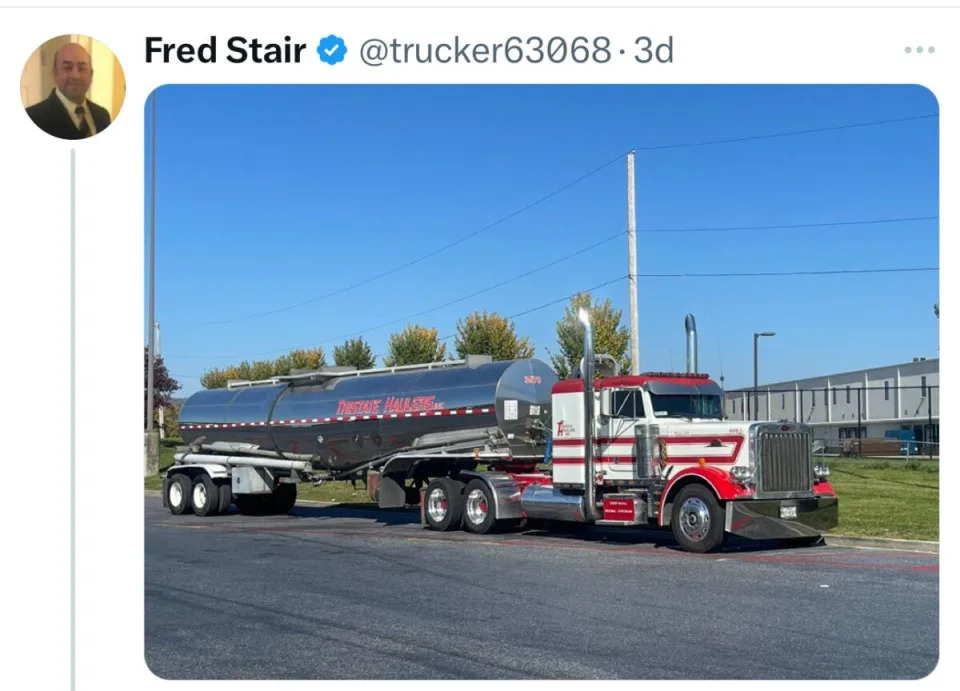
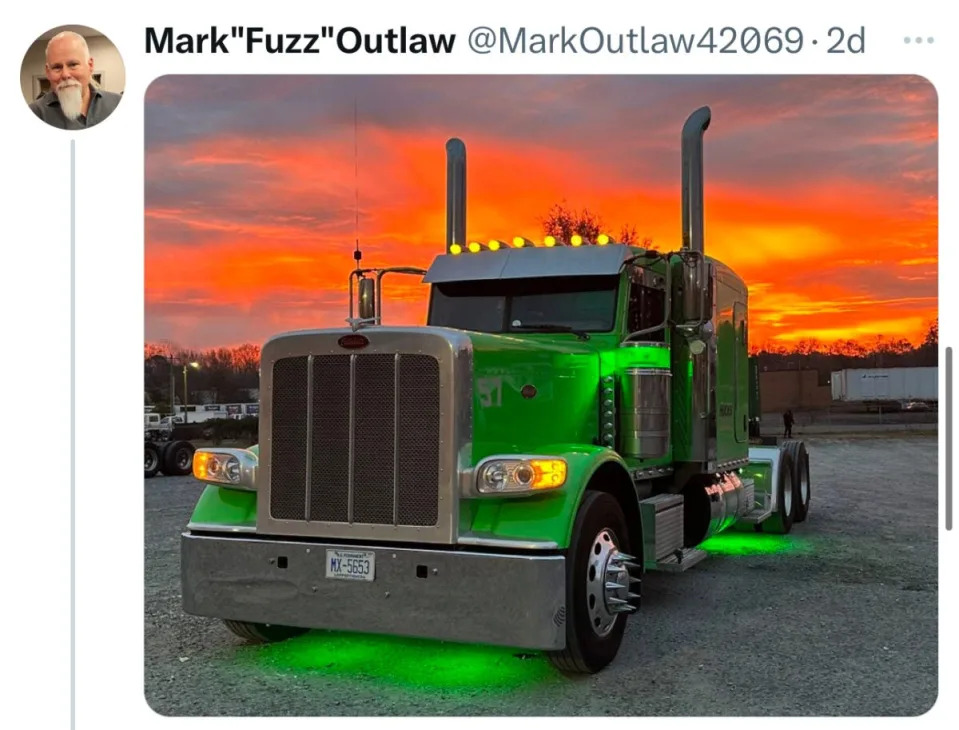
The post Winning in 2025: Smarter Business Decisions and Market Insights appeared first on FreightWaves .





